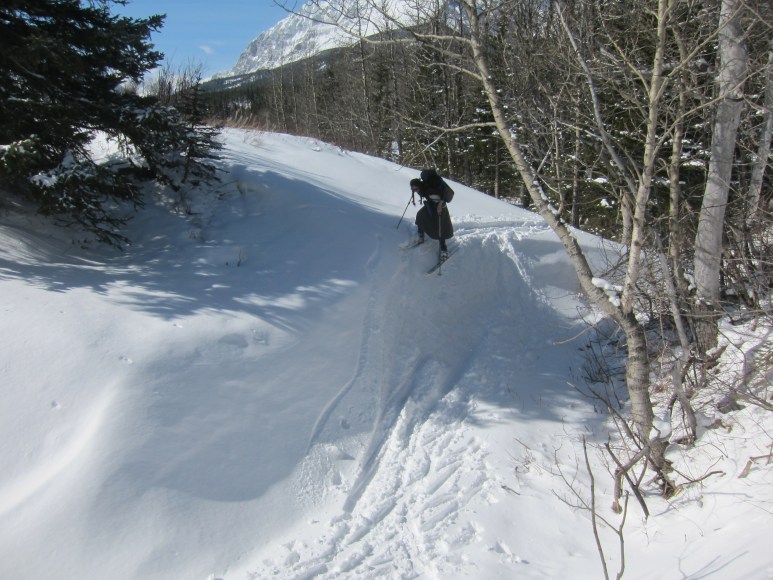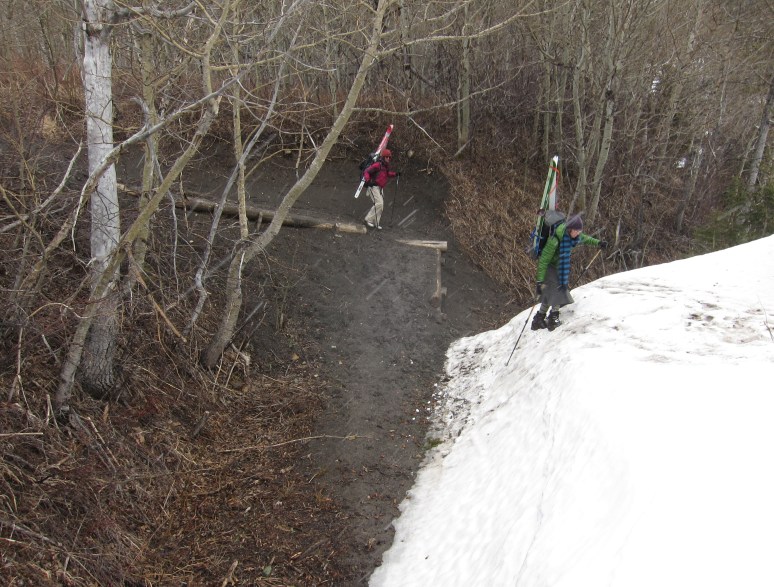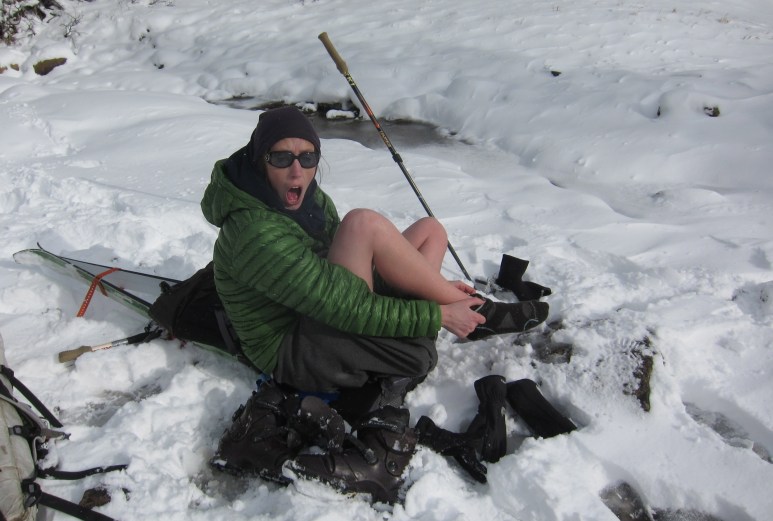A winter garden in an alder swamp,
Where conies now come out to sun and romp,
As near a paradise as it can be
And not melt snow or start a dormant tree.
Last fisher trip of the year; with the best last: the Belly River. In fifteen southwesterly arching miles the aspen foothills rise through a broad glacial valley to the cirques guarding Glaciers two highest peaks. I know of nowhere else such a direct journey is possible.
It lifts existence on a plane of snow
One level higher than the earth below,
One level nearer heaven overhead,
And last year’s berries shining scarlet red.
Calender winter turned into spring on our four day trip, but we experienced the transient footprints of those seasons in reverse. A warm winter and sunny days had the elevations below 6000′ feet too often bare. We did as much dirt skiing and mud slogging as anything on the way in. Within 20 minutes of reaching the ranger station and firing up the wood stove, a blizzard set in. The green grass just starting to sprout at the foot of the front porch was buried for the rest of our time.
It lifts a gaunt luxuriating beast
Where he can stretch and hold his highest feat
On some wild apple tree’s young tender bark,
What well may prove the year’s high girdle mark.
We settled in for work, and for luxury living. There’s a value in being out in the inhospitable, with contemplation lost to retrospect in the moment of exertion and survival; and there is something for only one extra, superfluous layer of comfort away from the maelstrom, observing every detail. It snowed off and on for all our first day, and every lit hour the next.
So near to paradise all pairing ends:
Here loveless birds now flock as winter friends,
Content with bud-inspecting. They presume
To say which buds are leaf and which are bloom.

The Belly River ranger station was built in 1925, and being there in the midst of a proper storm made it seem easy to grasp the lineage run through nearly a century of residents.
A feather-hammer gives a double knock.
This Eden day is done at two o’clock.
An hour of winter day might seem too short
To make it worth life’s while to wake and sport.
The early, if incomplete, entry of spring left us with no snow bridges. We waded with neo booties. The precise term for this is damn cold.

The snow and ambient temperature fell throughout the day. The skiing was sublime, enough fresh to pad out the bumps and slow us down, the hard base close enough for easy speed.
Dawn Mist Falls as living on in other guise.
At the end of our work I ran up to the foot of Elizabeth Lake as the storm intensified, and stood witness at the edge of nothingness.
M had stayed back that day and prepared a Saint Patrick’s feast: roasted corned beef, potatoes, candied carrots, onions and cabbage. And the four cans of Guiness I had packed in.
The next morning we woke up and did it all again.
Ouch.
Gros Ventre Falls. Third time I’d been buy, first time I’d bothered to go down the little spur trail and take a look. Seeing things first when they’re under snow is a privilege.
The sun began to let itself back in. The snow got sticky, the creek crossing back was slightly less hair raising, and we retreated back indoors a bit early. The previous days exertions had worn me thin, and while there can hardly be too much time out amongst the wild world, our window into the human history of the Belly was closing.
Last day: grand sendoff. That’s Cleveland free of cloud at right-center: highest in Glacier Park. Out of seven days in the Belly this winter and last, this is the only day I’ve seen it.
With more of Norton Pearl’s wisdom, we packed, cleaned, and were on our way.
It is hard to get hit off such a good rhythm when you keep stopping to look back.
The Belly proper, and Elizabeth Lake, goes to the left. The Mokowanis River, with Cosley, Glenns, Mokowanis, and Margaret Lakes, goes right. The rightward angling pass just not hidden at center is Stoney Indian Pass, on the Continental Divide.
Yes, you can packraft that river, and it’s a good one.
In sharp contrast to three days prior, we skied every inch of the way out. Until we got to where they were plowing the road.
Compare this photo to the one (above) of M booting the same drift on the way in.

If winter is the height of nature’s refuge, with cold and tough trail breaking guiding the statement, the first signs of spring are a firming snowpack and clearing roads. Soon our temples will be easier to visit.
You can’t be totally sure that’s a good thing,
(“A Winter Eden” as quoted above by Robert Frost.)




















Leave a reply to DaveC Cancel reply